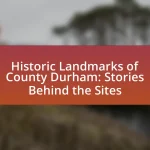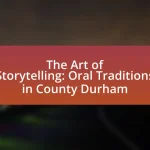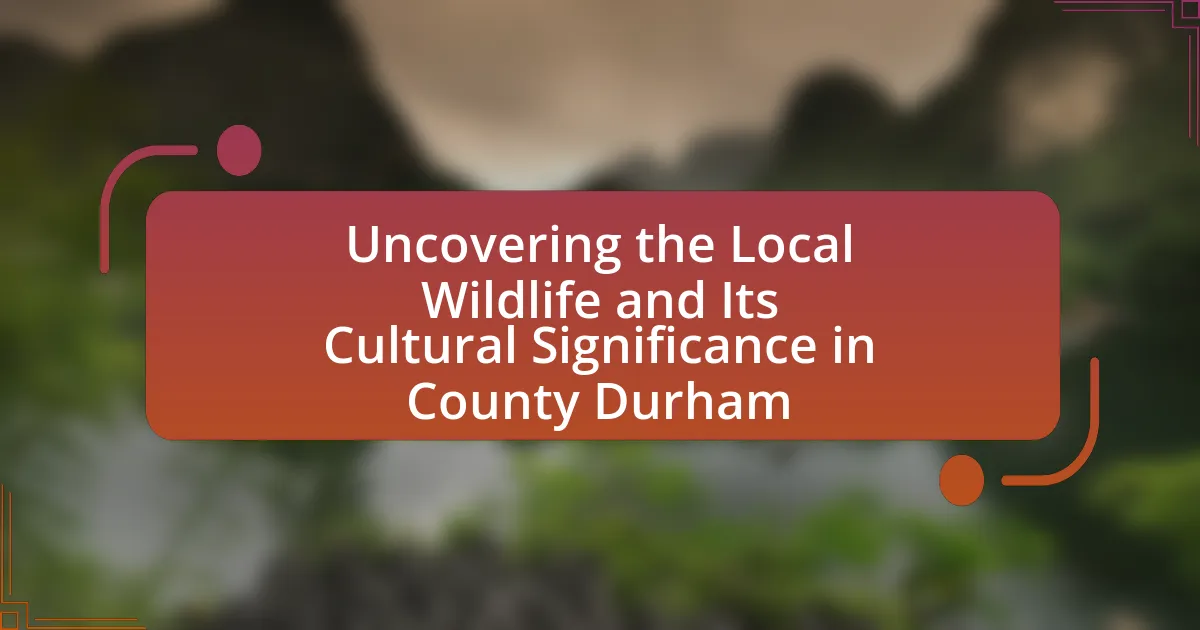The article examines the intricate relationship between nature and local culture in County Durham, highlighting how the region’s landscape, including the North Pennines and the River Wear, has shaped its historical and cultural identity. It discusses the influence of natural features on local traditions, agricultural practices, and community events, such as the Durham Miners’ Gala and the Bishop Auckland Food Festival. The article also addresses the challenges posed by urbanization and industrialization, as well as ongoing efforts to preserve this vital connection through community engagement and conservation initiatives. Overall, it underscores the significance of nature in defining the cultural heritage and identity of County Durham.

What is the Connection Between Nature and Local Culture in County Durham?
The connection between nature and local culture in County Durham is deeply rooted in the region’s landscape, which has shaped its historical and cultural identity. The natural features, such as the North Pennines Area of Outstanding Natural Beauty and the River Wear, have influenced local traditions, folklore, and community activities. For instance, the annual Durham Miners’ Gala celebrates the mining heritage, which is intrinsically linked to the region’s natural resources. Additionally, the area’s rich biodiversity and scenic beauty inspire local arts, crafts, and festivals, reflecting a strong appreciation for the environment. This interplay between nature and culture is evident in the preservation of local customs that honor the landscape, such as the use of natural materials in traditional crafts and the promotion of outdoor activities that foster community engagement with the natural world.
How does nature influence local cultural practices in County Durham?
Nature significantly influences local cultural practices in County Durham through its landscapes, resources, and seasonal changes. The region’s rich natural environment, including the North Pennines and the Durham Dales, shapes traditional activities such as farming, foraging, and festivals that celebrate the changing seasons. For instance, the agricultural practices in County Durham are closely tied to the local climate and soil conditions, which dictate crop selection and farming methods. Additionally, events like the Durham Miners’ Gala reflect the historical relationship between the community and its natural resources, emphasizing coal mining and its impact on local identity. The presence of natural landmarks also inspires local folklore and artistic expressions, reinforcing the connection between the environment and cultural heritage.
What specific natural features shape the cultural identity of County Durham?
The specific natural features that shape the cultural identity of County Durham include the Durham Dales, the River Wear, and the North Pennines. The Durham Dales, characterized by rolling hills and valleys, influence local traditions and agricultural practices, fostering a strong sense of community and heritage. The River Wear, which flows through the heart of Durham, has historically been a vital resource for trade and transport, contributing to the region’s economic development and cultural exchanges. Additionally, the North Pennines, designated as an Area of Outstanding Natural Beauty, provide a backdrop for outdoor activities and conservation efforts, reinforcing the local identity tied to nature and environmental stewardship. These features collectively contribute to the distinct cultural landscape of County Durham, reflecting the interplay between the natural environment and local customs.
How do local traditions reflect the natural environment of County Durham?
Local traditions in County Durham reflect the natural environment through practices that celebrate and utilize local resources. For instance, the tradition of lead mining in the region is deeply intertwined with the area’s geology, showcasing how the landscape has shaped economic activities and cultural heritage. Additionally, festivals such as the Bishop Auckland Food Festival highlight local agricultural produce, emphasizing the importance of farming and the natural landscape in community identity. These traditions not only preserve historical practices but also foster a connection to the unique ecological features of County Durham, illustrating the symbiotic relationship between the environment and local culture.
Why is the relationship between nature and culture important in County Durham?
The relationship between nature and culture is important in County Durham because it shapes the identity and heritage of the region. The natural landscape, including the North Pennines and the Durham Dales, influences local traditions, arts, and community practices. For instance, the area’s rich mining history is intertwined with its natural resources, which has fostered a unique cultural narrative that reflects the relationship between the environment and the people. Additionally, the preservation of natural sites, such as the UNESCO World Heritage Site of Durham Castle and Cathedral, highlights the significance of nature in cultural expression and tourism, contributing to the local economy and community pride.
What role does this connection play in community identity?
The connection between nature and local culture in County Durham plays a crucial role in shaping community identity by fostering a sense of belonging and shared heritage among residents. This relationship is evident in the way local traditions, festivals, and practices are often intertwined with the natural landscape, such as the celebration of agricultural events that highlight the region’s rural character. Historical evidence shows that communities in County Durham have relied on their natural surroundings for resources, which has influenced their cultural expressions and social cohesion. For instance, the preservation of local landmarks and natural sites serves as a reminder of the community’s history and values, reinforcing a collective identity that is deeply rooted in the environment.
How does it impact local tourism and economy?
The connection between nature and local culture in County Durham significantly enhances local tourism and economy. This relationship attracts visitors seeking outdoor experiences, cultural heritage, and historical sites, which in turn stimulates economic growth through increased spending in local businesses. For instance, the presence of natural attractions like the Durham Dales and the North Pennines Area of Outstanding Natural Beauty draws approximately 2.5 million visitors annually, contributing around £300 million to the local economy. This influx supports jobs in hospitality, retail, and services, demonstrating a direct correlation between nature, cultural engagement, and economic vitality in the region.
What are the historical perspectives on nature and culture in County Durham?
The historical perspectives on nature and culture in County Durham reveal a deep interconnection shaped by geography, industry, and local traditions. The region’s natural landscape, characterized by the River Wear and the surrounding moorlands, has influenced cultural practices, such as agriculture and mining, which have been central to the local economy since the medieval period. Evidence of this can be seen in the development of the coal mining industry in the 19th century, which not only transformed the physical landscape but also shaped community identities and social structures. Additionally, the area’s rich history of religious and cultural festivals, often tied to seasonal changes and agricultural cycles, underscores the significance of nature in local cultural expressions. Historical records, such as those from the Durham County Record Office, document these interactions, illustrating how the natural environment has continually informed the cultural narrative of County Durham.
How have historical events shaped the current cultural landscape?
Historical events have significantly shaped the current cultural landscape by influencing social norms, traditions, and community identities. For instance, the Industrial Revolution transformed County Durham from a predominantly agrarian society to an industrial hub, leading to the establishment of mining communities that fostered unique cultural practices and collective identities. The decline of coal mining in the late 20th century further reshaped the region, prompting a cultural shift towards heritage preservation and tourism, as seen in initiatives like the Durham Miners’ Gala, which celebrates the region’s mining history. These events have created a rich tapestry of cultural expressions that reflect both the historical struggles and resilience of the local population.
What traditional practices have evolved from the natural surroundings?
Traditional practices that have evolved from the natural surroundings in County Durham include the use of local flora for herbal remedies, the crafting of traditional textiles using locally sourced materials, and the celebration of seasonal festivals that align with agricultural cycles. For instance, the use of plants such as nettles and elderflowers in traditional medicine reflects the region’s rich biodiversity. Additionally, the weaving of wool from local sheep breeds into garments showcases the integration of natural resources into cultural identity. Seasonal festivals, such as harvest celebrations, are rooted in the agricultural calendar, emphasizing the community’s connection to the land and its resources. These practices illustrate how the natural environment has shaped cultural traditions and community life in County Durham.
How do local communities engage with nature in County Durham?
Local communities in County Durham engage with nature through various activities such as conservation projects, outdoor recreation, and community events focused on environmental awareness. For instance, initiatives like the Durham Wildlife Trust involve local volunteers in habitat restoration and species monitoring, fostering a sense of stewardship towards the natural environment. Additionally, residents participate in outdoor activities such as hiking, cycling, and birdwatching in areas like the North Pennines Area of Outstanding Natural Beauty, which promotes physical health and community bonding. Events like the annual County Durham Environment Awards celebrate local efforts in sustainability and conservation, further enhancing community involvement with nature.
What specific cultural events celebrate the connection to nature?
Specific cultural events that celebrate the connection to nature in County Durham include the Durham Miners’ Gala, which emphasizes the region’s mining heritage and its relationship with the natural landscape, and the Bishop Auckland Food Festival, which showcases local produce and promotes sustainable farming practices. These events highlight the importance of nature in local culture by fostering community engagement and environmental awareness. The Durham Miners’ Gala has historical significance, dating back to 1871, and attracts thousands of participants, reinforcing the cultural identity tied to the natural environment. The Bishop Auckland Food Festival, held annually, features local farmers and artisans, emphasizing the connection between agriculture and the surrounding landscape.
How do these events promote environmental awareness?
Events in County Durham promote environmental awareness by engaging the community in activities that highlight the importance of local ecosystems and sustainable practices. These events often include educational workshops, guided nature walks, and clean-up initiatives that directly involve participants in environmental stewardship. For instance, studies show that community-based events can increase knowledge about biodiversity and conservation efforts, leading to a greater commitment to protecting natural resources. By fostering a connection between local culture and nature, these events encourage residents to appreciate and actively participate in the preservation of their environment.
What are the most popular festivals or activities related to nature?
The most popular festivals and activities related to nature in County Durham include the Durham Wildlife Trust’s annual events, the Bishop Auckland Food Festival, and the annual Great North Run, which celebrates the region’s natural landscapes. These events engage the community with nature through activities like guided nature walks, wildlife conservation workshops, and outdoor sports. For instance, the Durham Wildlife Trust organizes events that attract thousands of participants, promoting awareness of local biodiversity and conservation efforts. The Bishop Auckland Food Festival emphasizes local produce and sustainable practices, showcasing the connection between agriculture and the natural environment. The Great North Run, while primarily a running event, takes participants through scenic routes that highlight the area’s natural beauty, fostering a deeper appreciation for the landscape.
What challenges does the connection between nature and local culture face in County Durham?
The connection between nature and local culture in County Durham faces challenges such as industrialization, environmental degradation, and loss of traditional practices. Industrial activities, particularly in mining and manufacturing, have led to habitat destruction and pollution, which disrupts the natural landscape that is integral to local cultural identity. Additionally, urbanization has contributed to a decline in traditional agricultural practices, diminishing the community’s relationship with the land. Studies indicate that these factors not only threaten biodiversity but also erode cultural heritage, as local customs and knowledge tied to the natural environment become less relevant in modern society.
How do urbanization and development impact this relationship?
Urbanization and development significantly alter the relationship between nature and local culture in County Durham by leading to habitat loss and cultural displacement. As urban areas expand, natural landscapes are often transformed into residential and commercial spaces, diminishing the connection residents have with their environment. For instance, the construction of new housing developments can disrupt local ecosystems, which in turn affects traditional practices tied to the land, such as farming and foraging. Studies indicate that as urbanization increases, communities may experience a decline in cultural heritage linked to natural resources, as seen in the reduction of local biodiversity and the erosion of traditional knowledge systems. This dynamic illustrates how urban growth can undermine the intrinsic ties between nature and cultural identity in the region.
What efforts are being made to preserve this connection?
Efforts to preserve the connection between nature and local culture in County Durham include community-led initiatives, educational programs, and conservation projects. Local organizations, such as the Durham Wildlife Trust, actively engage residents in habitat restoration and biodiversity conservation, fostering a sense of stewardship towards the natural environment. Additionally, cultural events that celebrate local traditions and natural heritage, such as the annual Durham Miners’ Gala, reinforce the bond between the community and its landscape. These initiatives are supported by research indicating that community involvement in conservation enhances both ecological outcomes and cultural identity, as highlighted in studies by the University of Durham.
What practical steps can individuals take to strengthen the connection between nature and culture in County Durham?
Individuals can strengthen the connection between nature and culture in County Durham by participating in local conservation projects and cultural events that celebrate the region’s natural heritage. Engaging in activities such as tree planting, habitat restoration, and wildlife monitoring fosters a sense of stewardship for the environment while enhancing cultural awareness. Additionally, attending or organizing events like nature walks, art exhibitions inspired by local landscapes, and traditional festivals that highlight the relationship between the community and its natural surroundings can deepen this connection. Evidence of this approach can be seen in initiatives like the Durham Wildlife Trust, which promotes community involvement in nature conservation, thereby linking ecological health with cultural identity.




